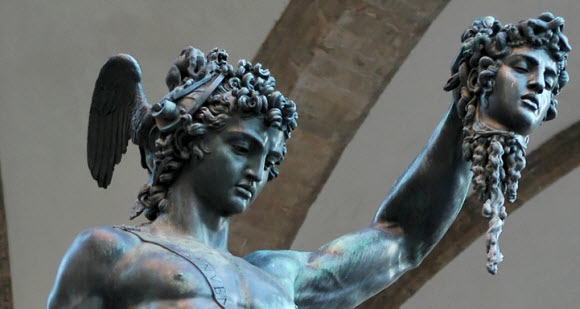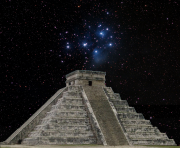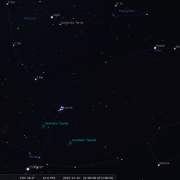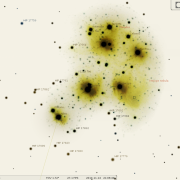Ah, mid autumn, the ‘witching season’, a time in the year most associated with ghoulish revelry, the tragic and the macabre. Not surprisingly the autumnal night sky plays host to a reflection of such ‘unearthly goings on’, manifest as tales associated with the stars and constellations.
So, are you sitting comfortably? Good. Let us begin with one of the oldest and most intricate tales associated with the heavens, one that incorporates a number of important and ancient constellations currently located in the night sky.

Perseus slew Gorgon Medusa, and with her head defeated the Craken Sea Monster who was turned to stone.
As one of the great heroes of Greek mythology, stories associated with Perseus can be traced as far back as the 5th century BC. Perseus was the son of Zeus and Danae and great grandfather of Heracles. Of all Perseus’s deeds, his the quest to kill the Gorgon is best known. Perseus was tasked to do this by King Polydectes, who for his own ends wanted Perseus out of the way. This particular Gorgon – Medusa, was a hideous creature with snakes for hair, a face covered with dragon scales and sporting tusks, and whose glance could turn the unfortunate to stone. Unbeknown to the Polydectes, to aid in his quest the gods furnished Perseus with various items, including a polished bronze shield, a sword of diamond, a helmet of darkness and winged sandals. Pretty useful items! Perseus defeated Medusa by catching her reflection in his polished shield, before decapitating her with his sword. According to one legend, from the blood soaked ground sprang forth the great winged horse Pegasus and the warrior Chrysaor.
En route home, Perseus spied far below a beautiful young woman chained to a rocky promontory. Churning toward her was a huge monster. The woman; Princess Andromeda, was in this predicament through no fault of her own. Daughter of Queen Cassiopeia and King Cepheus, Cassiopeia had boasted that the beauty of Andromeda surpassed that of the sea nymphs, enraging the sea god, Poseidon, who sent a sea monster, the Craken to ravage the coast of King Cepheus’ kingdom. According to the oracle the only way to appease Poseidon was by the sacrifice of Andromeda. So, it was that in the nick of time, Perseus tricked the Craken into looking directly at the severed head of Medusa, instantly turning the monster to stone. Hero and heroine were duly wed. Later Perseus took his revenge on King Polydectes by turning him into a pillar of stone. Athene then took the head of Medusa and set it in the middle of her shield. The whole cast of characters in this, dramatis personae, are all to be found arcing across the autumn night sky.

Perseus later used Medusa's Head to turn turn the treacherous King Polydactes to stone after the King had tried to kill him.
The constellation of Perseus itself partly lies within the Milky Way and contains some fine deep sky objects, in particular the Perseus double cluster, which on star charts marks the hero’s sword. It is regarded by many amateur astronomers as one of the loveliest sights visible in smaller instruments, a stellar jewel box! The cluster lies midway between Perseus and Cassiopeia.
Perseus’s chief star is called Mirphak (or Mirfak), however, Beta Persei, or Algol is of far more interest. Throughout early antiquity it was noted with much consternation that this star appeared to ‘wink’ every third day. The star became known as ‘the demon’s head’ from the Arabic word ra’s al-ghul (رأس الغول). It is doubtful if the Arabs knew of the Perseus–Medusa legend, but they had an equally terrible one of their own, a Ghul, a nightmare that haunted and ultimately destroyed men. This star was certainly viewed with great suspicion and as such considered dangerous or unlucky. Older star charts have Algol marking the decapitated head of Medusa - the ‘demons head’. Science has long since uncovered the truth behind Algol and we now know it to be a eclipsing binary consisting of two stars orbiting close together, the fainter component passing directly in front of the primary every 2 days; 21 hours, the eclipse process or ‘wink’ lasting almost ten hours before the eclipse ends, thereafter the ‘demon star’ returns to normal.
To the lower right of Perseus a crooked line of 3 stars denote Aries the ram, the tale of which is a prequel to another well known legend. The initial story relates to the king of Thebes, who was tricked by his scheming second wife into sacrificing the children of his first marriage. Zeus, who was much troubled by this, asked Hermes to rescue the children- Phrixus and Hellas. Hermes sent a flying ram on which they escaped on the night of their sacrifice. Tragically en-route to safety, Hellas - the girl, fell from the ram and drowned in the place that is today known as the Hellespont near Greece. After safely landing Phrixus sacrificed the ram, whereupon its fleece turned to gold, possessing the power to heal anyone covered by it. It is this very same fleece, hung in the sacred grove of Colchis and guarded by a terrible serpent that was forcibly removed after many adventures by Jason and his Argonauts.
Let us turn our gaze now towards the Pleiades, or ‘Seven Sisters’, regarded as the loveliest open star cluster in the entire heavens and certainly one of the most youthful by stellar standards, around 100 million years old. To the casual glance the Pleiades appear as beads of dew on a frosty web. Keen sighted observers can make out more than seven stars with the naked eye, although most people see five or six. Binoculars, or very low telescopic magnifications reveal dozens of stars and the entire cluster contains over 300 members approximately 380 light years away.
Revered throughout antiquity, in Greek mythology the Pleiades were the seven daughters of Atlas and the Oceanid Pleione, after whom they are named. In one tale Orion pursued the sisters for seven years after trying to ravish them and their mother. Zeus immortalized the chase by placing the Pleiades in the heavens. However in another tale Zeus himself seduced three of the sisters. No morals at all, these Gods!

Mayan Pyramid of
Consciousness (illustrated
with Pleiades backdrop)
Of course these legends were not real events, but ancient Aztec and Mayan traditions tell of all too real and gruesome rituals associated with the Pleiades. Then, the midnight culmination of the star cluster was an event of ominous significance, especially so every 52 years when time lines of separately used calendars converged. Believing the world would end at such times, temple steps would run red with the blood of virgins, sacrificed in order to postpone the approaching apocalypse.
Travel to Mexico today and many of the sacred ‘step’ pyramids have their west face orientated to the setting position of the Pleiades. Even as late as the 13th century a sinister influence was first attributed to the Pleiades, when the midnight culmination became the traditional date of the fearsome Witches' Sabbath or Black Sabbat, a night of unholy revelry, a date that preserves the memory of ancient druids' rites, observed today as All Hallows eve – Halloween.
Clear skies – and don’t have nightmares!
- Log in to post comments



